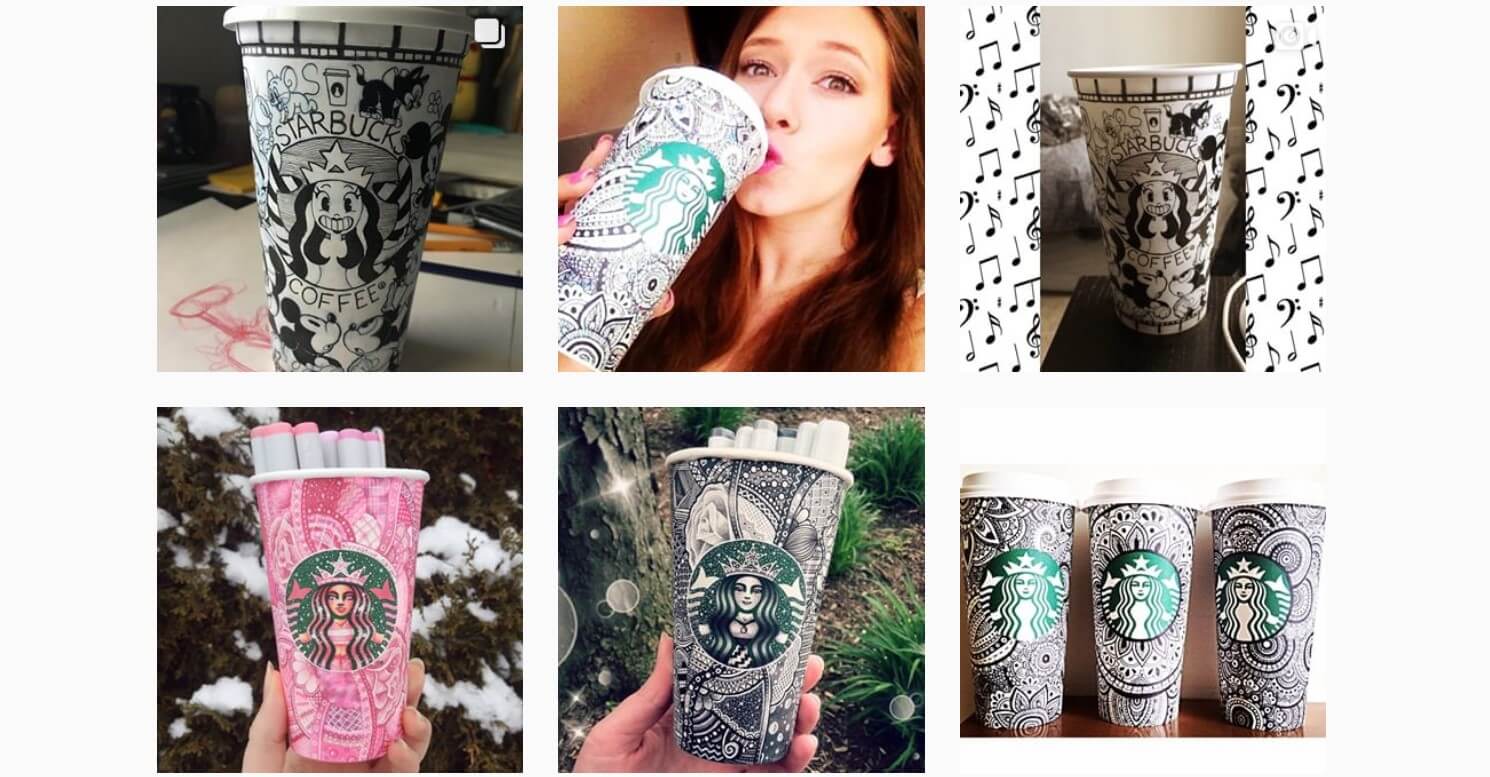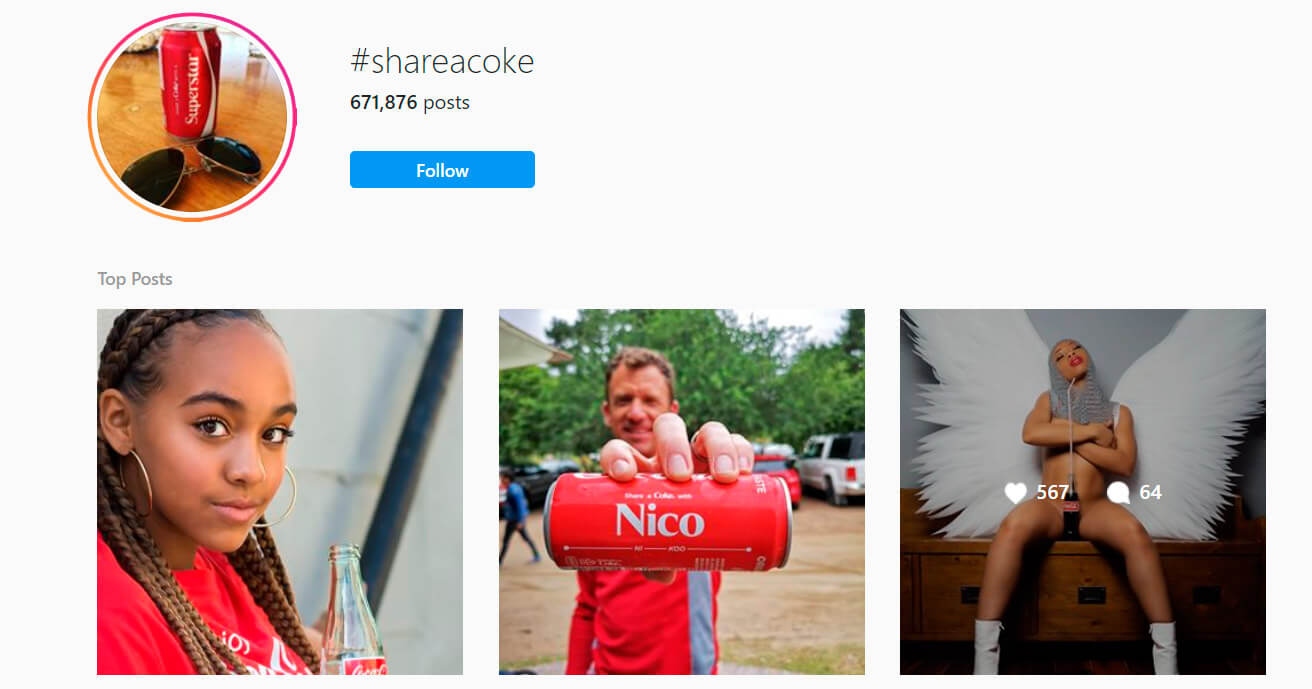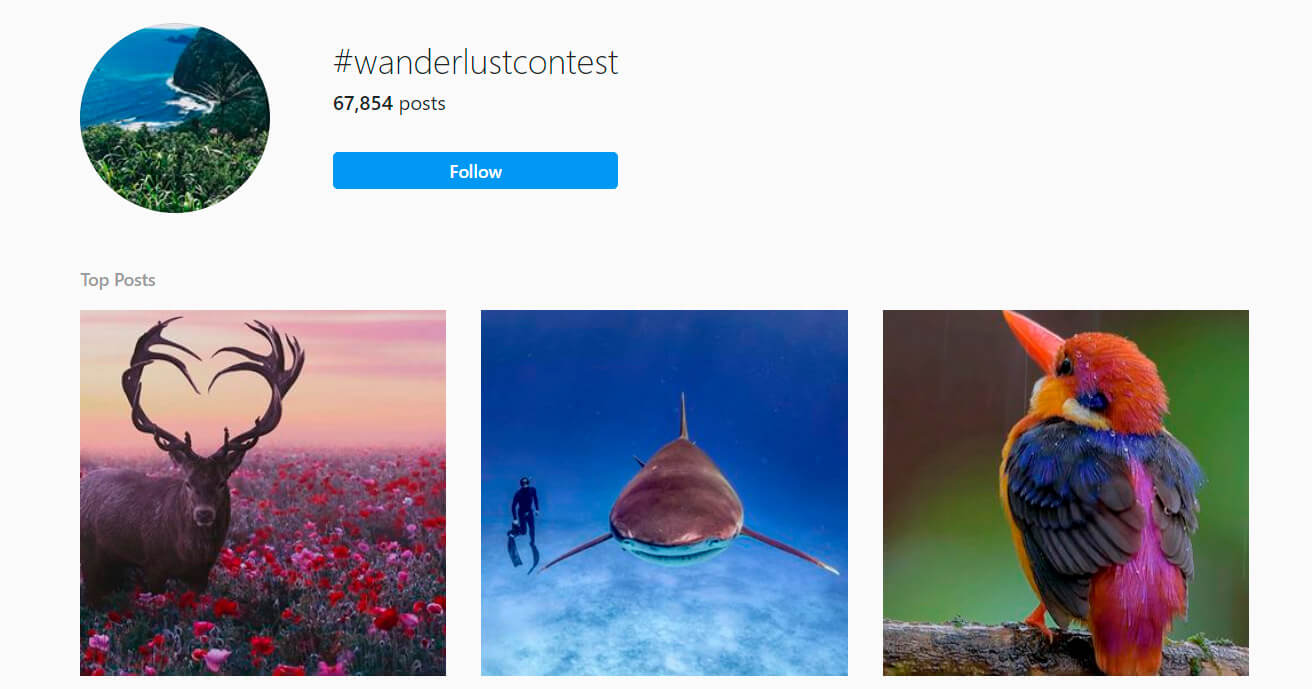What is user-generated content?
The term UGC (User-generated Content) refers to any digital content produced and shared by end users of an online service or website. It includes pictures, reviews, videos, testimonials, tweets, blog posts, podcasts, etc. User-generated content helps online visitors learn about your business or services and is often considered more authentic and trustworthy than company-generated content. User-generated content examples include famous campaigns such as the Starbucks White Cup Contest, which was launched in 2014.

Types of UGC
Experts say that traditional advertising methods are no longer cutting it, so marketers are in constant search for new marketing techniques which will help authentically connect with customers and create a lifestyle around brands. UGC is one of the most powerful marketing strategies to turn your customers into loyal advocates. To achieve this aim, you can leverage various UGC types the internet abounds in. Let’s take a closer look at some common types of user-generated content.- Reviews and video testimonials. Most people trust online reviews like they trust their friends and relatives. Incentivize your customers to both write reviews and to share them on social media.
- Contests can work miracles for collecting user-generated content. Choose a prize aligning with your audience’s interests, find out what your followers are really passionate about and encourage them to share their experiences with the hashtag you’ve created and you’ll be able to generate tons of relevant content.
- Hashtag campaigns allow you to engage your audience on an ongoing basis. Moreover, they help to create brand awareness and recognition. Hashtagged images or posts are perceived as word-of-mouth advertising. Though you may offer some perks for hashtagging your brand, lots of people can willingly do this just to be featured on your brand’s account.
- Blog posts can contain tweets or posts from your customers. You can use your customers’ photos or videos to prove a point or give an example (for instance, styling a dress you sell or decorating a flat with your goods). This will give you a chance to increase social traffic and improve the quality of your posts in general.
- Question and answer forums. Inspire your customers to ask you questions in order to get some content prompts and boost your SEO, as questions are good for long-tail SEO.
What makes user-generated content so effective?
The power of user-generated content for marketing is hard to overestimate. Some people even call it the Holy Grail of modern marketing. UGC has been found to be 20% more effective than branded marketing alone. The main reason for this is that conventional advertising strategies are no longer effective as consumers are wary of ubiquitous advertising and are biased against it, so they trust a recommendation from strangers over branded content. As UGC is produced by people who won’t earn a penny from praising your product or service, it’s perceived as more authentic and trustworthy.The benefits of using user-generated content in marketing
UGC can be an invaluable tool for marketers, if harnessed properly. It is a workable solution to many marketing problems, such as insufficient time and monetary resources, lack of customer trust and low credibility. We’ve listed the benefits of user-generated content you can gain if you integrate UGC in your marketing. So, UGC allows you to:Enhance brand awareness
Brand awareness is the level of recognition and familiarity of your brand among consumers. Building brand awareness is a prime marketing goal and it requires a lot of time and effort to make your brand a household name. UGC is a great way of spreading your brand by word of mouth, as UGC is 35% more memorable and 20% more influential on purchase decisions than all other media types, according to a study conducted by Ipsos MediaCT. Moreover, people often discover brands on UGC-related sources such as search engines, social networks, customer review sites and a brand’s online community.Establish credibility as a thought leader
Who is a thought leader? An individual who has a reputation of credible experience and commentary. The ideas of thought leaders guide the direction of an industry or community. However, the trust and credibility are not the only rewards to be reaped from being a thought leader. Such leadership draws in an audience and, consequently, results in increased revenue. Becoming an expert in your niche and knowing your sphere inside and out is not enough to become an established thought leader. Digital behavior is greatly similar to herd mentality, which means that a customer considers you an expert if other customers do the same. People rely on the opinions of others for distinguishing right from wrong. That is why it’s crucial to leverage UGC to establish credibility as a thought leader in your niche.Streamline lead nurturing
Lead nurturing is a marketing term for building relationships with potential clients, even if they are not ready to buy. Lead nurturing aims at building customer awareness of your brand and its products or services, establishing trust and educating potential customers about your offerings. This technique can potentially influence the buying decisions of the customers who are on the fence about your product. UGC can be a valuable asset for your lead nurturing campaigns, as it helps to move the focus away from the brand to customers and builds engaged communities around it. How can UGC be integrated into your lead nurturing campaigns? Firstly, you can use customer stories to introduce your benefits and products, promote new products and answer common questions. Besides, customer surveys offer critical insights into problem areas of your business and help to fare better. Furthermore, while requiring no effort from you, video testimonials are advantageous for building trust with new potential customers.Boost social media metrics
Social media metrics are data and statistics that give you insights into your social media marketing performance, including applause rate, shares, post reach, audience growth rate, potential reach, conversion rate, bounce rate, etc. Experts agree that UGC techniques are helpful for increasing all these important social media stats.Improve SEO
Why is user-generated content important for boosting SEO? There are several reasons for it.- UGC provides search engines with a constant stream of fresh, relevant and trustworthy content.
- Basic SEO attributes penetrate UGC naturally as customer reviews are product-centered and include phrases and keywords associated with the product, thus strengthening SEO.
- UGC allows your site to rank higher for long-tail keywords − phrases with low search competition.
- UGC boosts SEO through social media optimization on platforms like Instagram, Facebook and Sharing content on social sites increases engagement and drives more visitors to your site. It leads to your site visibility boost and, consequently, your site performs better on search engines.
- UGC should be a vital part of any SEO strategy, as automated search engine algorithms look for customer reviews and testimonials. Leveraging UGC allows your site to earn additional SEO points from quality rating systems.
Support lead generation
Lead generation is a marketing strategy that involves attracting and converting potential customers (leads) who may be interested in your product or service. If you play your cards right, you may eventually turn leads into money. How can UGC bolster lead generation? Online word of mouth or earned media has always been more powerful and influential for attracting potential customers than owned media created by your brand. Hence, one of the best ways to generate new leads is through UGC.Where can you use UGC?
To harness UGC properly, share it on all available marketing channels including earned, owned and paid media. Earned media is basically online word of mouth in the form of shares, reviews, mentions, ratings, etc. UGC from earned media impacts SEO results greatly and can be repurposed with other media, so you should encourage and inspire your audience to generate and share your brand-related content. Owned media includes the digital channels a company has complete control over; for example, a website, a blog, social media pages, mobile apps and newsletters. Using UGC on your owned media can add authenticity to your brand and create a unique brand image. Paid media comprises external marketing efforts involving a paid placement; for example, PPC advertising, affiliate marketing, retargeting, branded content, display ads, paid influencers, etc. Utilizing UGC in paid media helps to establish trust and differentiate a brand from competitors. Moreover, with the help of paid media, you can reach people who don’t use social media a lot. Of course, if you are an owner of a small travel website, it’s usually not worth following UGC, but in case you’re building own brand, the UGC can be a reasonable step to improve your business. For example, UGC can be a great way for the White Label projects or independent flight tickets engines. If you haven’t read our interview with Maho, the creator of one of the biggest Georgian flight tickets booking website, don’t miss the chance to do it now.Creating a user-generated content strategy
So, you’ve decided that you are ready to implement UGC in your marketing. What do you need to start? The first thing is to work out a UGC strategy which will align with your marketing aims. A thorough UGC strategy can help you:- Manage your UGC campaigns effectively from the very beginning
- Monitor the performance of your UGC campaigns
- Schedule the work of your teams involved in UGC in advance
- Reduce the failure risks of your UGC campaign
1. Understand your needs
- State what your campaign aims at. For example, it may be getting feedback or promoting a product.
- Define the duration of your campaign.Campaigns may be limited to a time period, or ongoing if the purpose behind the campaign is long-term, for instance, building your brand awareness.
- Decide what UGC type you’ll use.
2. Understand your audience
- Define the “who, where and how” of your UGC production, and what incentive they’ll need for sharing this content.
- Understand what audience will consume the content, what content they would like to see and where.
3. Plan your campaign
- Define your campaign goals in terms of numbers you want to achieve, including the numbers of shares, submissions, etc.
- Build anticipation. Promote your campaign on relevant platforms in advance.
- Choose a platform on which you’ll communicate with your audience. Make sure you provide your audience with comprehensive information about the rules, deadlines and guidelines of your campaign. You should also give sample content to inspire your customers.
- Define the submission mode. Users can either share content with your brand hashtag or upload it on the platform you’ve chosen.
- Resolve legal issues. Draft your brand’s UGC legal agreement covering such aspects as the ownership of the content, consent for the single or multiple uses and places where this content can be further used.
- Decide on the prize and the judging criteria for your campaign.
Monitor the performance of your campaign
It’s essential to check the progress and quality of UGC while the campaign is in progress.Engaging with your customers to create UGC
Taking all the advantages of UGC into consideration, it’s clear that UGC is a crucial part of any successful marketing strategy. But, most of you are now interested in how to get user-generated content from your customers. Make sure you engage your customers at the key moments of their purchase process to bring about positive, appealing and inspiring UGC for your business:- Incentivize your customers to generate UGC at the point of purchase taking advantage of their delight.
- Encourage customers to share their visual UGC after the purchase via various channels. There are numerous strategies you can implement for collecting UGC post purchase.
- You can send an email encouraging your existing customers to share a photo with their new purchase or create a unique, brand-specific hashtag to be used on different social media platforms.
- Moreover, brands can motivate their customers to upload their purchase photos via special photo sharing widgets, accumulate the uploaded photos and further create a kind of photo gallery on their sites.
- Gamify the experience. Discount codes, coupons, loyalty points, free gifts and giveaways are not only useful for boosting customer engagement, but they also lead to repeat purchases, thus building long-term relationships with your customers.
Tools for generating UGC
There are three channels from which you can get UGC. Asking for it, incentivizing it through contests or promotional campaigns and harnessing hashtag campaigns to encourage UGC sharing. To be effective, UGC should be featured frequently on various platforms and in different forms. So, if you are new to gathering content, the task may seem challenging for you. However, there are numerous user-generated content tools that can help you generate the type of UGC needed to boost your revenue.Review generation and display tools
Reviews are the backbone of UGC, as they create social proof and impact purchase decisions greatly. There are great review generating tools such as Yotpo, ResellerRatings and Vendasta, which allow you to automatically contact your customers in order to request reviews.UGC sharing & curation tools
UGC sharing & curation tools such as TINT and ReadyPulse enable you to create, place and monitor UGC streams on your site. Moreover, they offer you content curation and can be placed on your homepage, an assigned social page or next to a relevant product.Contest software
Contests are invaluable for generating UGC and establishing your brand awareness, but they require a lot of time and effort from you. Fortunately, there is contest software that can do wonders for making contests successful. Tools such as Shortstack and Wishpond allow you to create landing pages and widgets which can be placed on your site. With the help of these tools, you’ll be able to run a contest on various platforms, increasing audience engagement.Hashtag research tools
Social media is considered to bethe best source for generating UGC. While the main problem is the tracking of your brand-related UGC, a catchy and unique hashtag can turn out to be a viable solution to it. Hashtagify is an amazing tool for creating eye-catching and original hashtags.Inspiring examples of user-generated content marketing
Here are several inspiring examples of successful user-generated campaigns that can motivate you to implement UGC in your marketing. National Geographic #WanderlustContest launched in 2015 and is a striking example of how a brand with 130 years of history managed to adapt to the latest technological trends.




